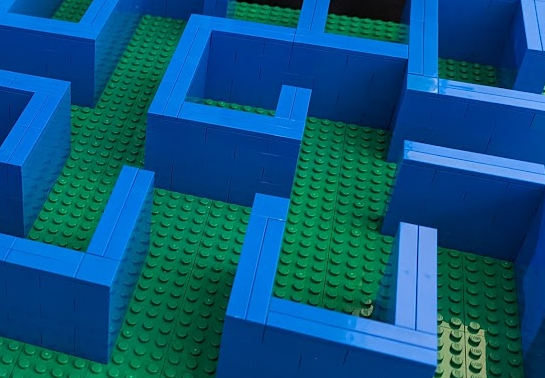Summary:
This post describes a design standard for collaborative LEGO maze making. It is our hope that this standard will be employed by the LEGO Fan community in much the same way that existing collaborative standards like Micro City, Habitats, and Moonbase have been used to create massively intricate pop up displays at LEGO Fan events worldwide. We hope that this simple framework will bring fans together in a creative pursuit that will result in an elaborate maze that is fun to view, while also being completely unique in every event it is presented.
5 Simple Rules:
- Your maze should be built upon a 32×32 or 48×48 baseplate, in the MILs standard. A MILs plate is any 32×32 or 48×48 baseplate that has been built up by having one layer of bricks and one layer of plates applied to its surface. Your base can include technic style bricks on the perimeter that allow for the plate to be connected to its neighbor via Technic pins, but that is not necessary for a complete maze module as will be shown.
- The outside 3 studs that make up the perimeter of your module are off limits and must be left open.
- Whenever possible, maze pathways should be at least 6 Studs wide.
- Your module must include at least two 2x6x5 free standing walls that can be used to connect your maze module to another LEGO Builders maze module.
- Your maze, when integrated into the collaborative, must not create a closed loop.
Perimeter Rule Explained:
The MAZE standard is meant to identify the loose set of expectations that make it possible to integrate your maze with anybody else’s maze with the least number of expectations. The most important expectation being the off limits 3 stud perimeter. Consider this example. We have 5 very similar maze modules that have all been connected with their free standing 2x6x5 connecting walls, highlighted in red:
Because each module has kept the 3 stud boundary clear, anybody can use their free standing wall to connect to another’s maze module.
Closed Loops Prohibited:
We would like our collaborative maze to have many solutions, and be free from inaccessible closed loops. When assembling the collaborative modules – be mindful of the entrances and exits for each maze module. IN the example above, we would not want to create a closed loop by misplacing the free standing walls in a way that closes off that maze from access:
Maze Pathway Width:
Consider the possibility that your maze may be integrated into a large maze collaborative that is going to be viewed at an angle, from the side. Your maze walls should be around 5 bricks high, with a 6 stud wide path, so guests viewing the collaborative maze are able to see into your maze and appreciate your design.
Maze examples:
A 48×48 sized maze module with simple 2 stud wide walls:
We can create a simple collaborative maze by using the two 2x6x5 walls we made to connect our big green and blue maze so a Star Wars themed 32×32 sized maze module:
Having left the 3 stud perimeter clear, connecting the 2 maze modules couldn’t be easier!
In this final example, a western fan has securely connected their wild west themed maze using their own free standing 2x6x5, theme appropriate, connecting walls:
